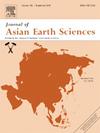Mud volcanoes and microbial communities: Unraveling the mysteries of formation, features, and occurrence
IF 2.7
3区 地球科学
Q2 GEOSCIENCES, MULTIDISCIPLINARY
引用次数: 0
Abstract
Over two thousand mud volcanoes have been documented worldwide, predominantly forming in geologically active regions characterized by rapid sedimentation, recent magmatic activity, and compressional tectonics. These features originate from gravitative instability and fluid overpressure, which induce hydrofracturing of impermeable strata, allowing the release of water, gas, and sediments to the surface. As a result, mud volcanoes occur across a range of tectonic and sedimentary settings, including active margins, accretionary complexes, thrust belts, and deep sedimentary basins. They are generally classified as either submarine or terrestrial mud volcanoes, with the former typically associated with tectonic deformation and the later with sediment accumulation in continental settings. Beyond their geological significance, mud volcanoes contribute substantially to global geochemical and biogeochemical processes, influencing methane production and consumption, nutrient cycling, and organic matter transformation. Additionally, microbial communities are essential in the formation and maintenance of mud volcano structures by contributing to the biomineralization of carbonates and sulfates. The microbial communities found in different mud volcanoes are diverse, and their composition can vary based on location, depth, and geochemical conditions. Moreover, these microbial communities have evolved to utilize diverse sources of energy, including hydrogen, methane, and sulfur, to facilitate metabolic processes. This review summarizes the current insights into the formation, distribution, and environmental constraints of mud volcanoes, while highlighting the ecological relevance and metabolic capabilities of associated microbial communities based on metagenomics data to support interdisciplinary research into geobiological interactions in extreme ecosystems.

泥火山和微生物群落:揭开形成、特征和发生的奥秘
据记载,全世界有两千多座泥火山,主要形成于地质活跃地区,其特征是快速沉积、近期岩浆活动和挤压构造。这些特征源于重力不稳定性和流体超压,它们会导致不透水地层的水力压裂,从而使水、气和沉积物释放到地表。因此,泥火山发生在一系列的构造和沉积环境中,包括活动边缘、增生复合体、冲断带和深沉积盆地。它们一般分为海底泥火山和陆相泥火山,前者通常与构造变形有关,后者则与大陆环境下的沉积堆积有关。除了地质意义之外,泥火山还对全球地球化学和生物地球化学过程做出了重大贡献,影响了甲烷的生产和消耗、养分循环和有机质转化。此外,微生物群落通过促进碳酸盐和硫酸盐的生物矿化,对泥火山结构的形成和维持至关重要。在不同的泥火山中发现的微生物群落是多种多样的,它们的组成可以根据位置、深度和地球化学条件而变化。此外,这些微生物群落已经进化到利用不同的能源,包括氢、甲烷和硫,以促进代谢过程。本文综述了目前对泥火山形成、分布和环境约束的认识,同时强调了基于宏基因组学数据的相关微生物群落的生态相关性和代谢能力,以支持极端生态系统中地质生物学相互作用的跨学科研究。
本文章由计算机程序翻译,如有差异,请以英文原文为准。
求助全文
约1分钟内获得全文
求助全文
来源期刊

Journal of Asian Earth Sciences
地学-地球科学综合
CiteScore
5.90
自引率
10.00%
发文量
324
审稿时长
71 days
期刊介绍:
Journal of Asian Earth Sciences has an open access mirror journal Journal of Asian Earth Sciences: X, sharing the same aims and scope, editorial team, submission system and rigorous peer review.
The Journal of Asian Earth Sciences is an international interdisciplinary journal devoted to all aspects of research related to the solid Earth Sciences of Asia. The Journal publishes high quality, peer-reviewed scientific papers on the regional geology, tectonics, geochemistry and geophysics of Asia. It will be devoted primarily to research papers but short communications relating to new developments of broad interest, reviews and book reviews will also be included. Papers must have international appeal and should present work of more than local significance.
The scope includes deep processes of the Asian continent and its adjacent oceans; seismology and earthquakes; orogeny, magmatism, metamorphism and volcanism; growth, deformation and destruction of the Asian crust; crust-mantle interaction; evolution of life (early life, biostratigraphy, biogeography and mass-extinction); fluids, fluxes and reservoirs of mineral and energy resources; surface processes (weathering, erosion, transport and deposition of sediments) and resulting geomorphology; and the response of the Earth to global climate change as viewed within the Asian continent and surrounding oceans.
 求助内容:
求助内容: 应助结果提醒方式:
应助结果提醒方式:


